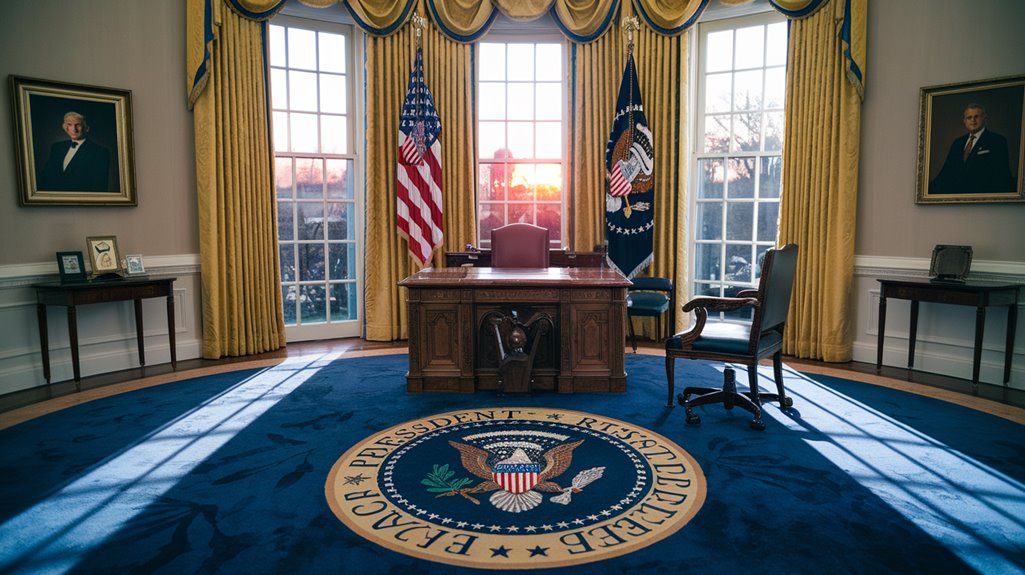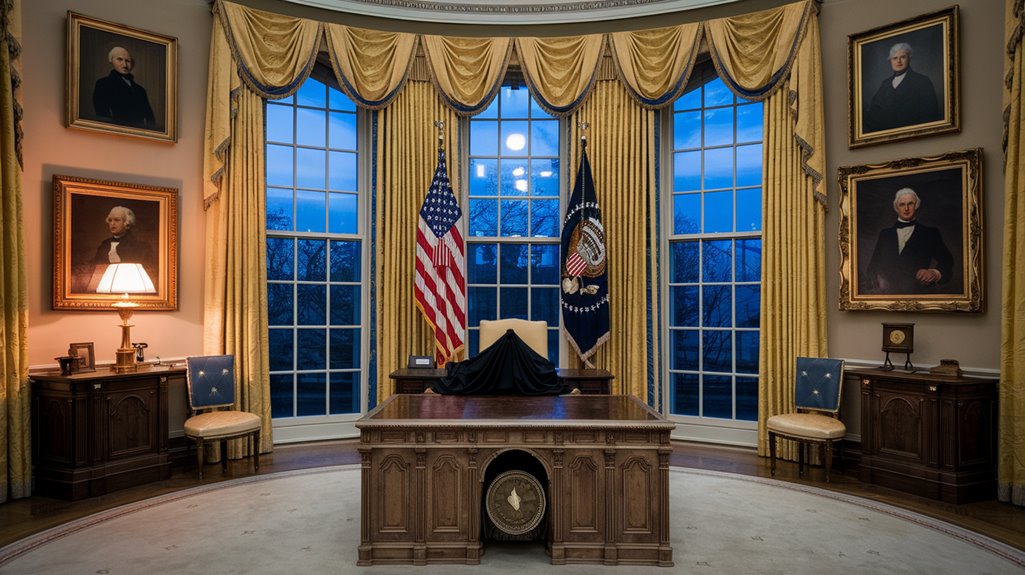Four U.S. Presidents Served Without a Vice President
You might be surprised to learn that nearly 10% of U.S. presidents have served part of their terms without a vice president. Before the 25th Amendment's ratification in 1967, there was no constitutional mechanism to fill a vice presidential vacancy. When John Tyler, Millard Fillmore, Andrew Johnson, and Calvin Coolidge found themselves without their second-in-command, they had to navigate the challenges of executive leadership alone. Their experiences would ultimately shape how we handle succession in the modern era.
The Constitutional Gap in Vice Presidential Succession

While the U.S. Constitution established the vice presidency as a vital position for presidential succession, it initially left significant constitutional ambiguity about how to handle vice presidential vacancies.
You'll find that before the Twenty-Fifth Amendment, there was no mechanism to fill an empty vice president position, leaving presidents to serve without their second-in-command.
The original Constitution only specified that the vice president's "Powers and Duties" would transfer if the president couldn't serve, but it didn't clarify whether the vice president became president or merely acted as one.
This lack of succession clarity created potential governance issues, especially during the nuclear age.
Today, a majority vote in both houses of Congress must confirm any new vice presidential nominee.
Prior to the Twenty-Fifth Amendment, the vice presidency remained vacant for over 20% of U.S. history.
Congress attempted to address these gaps through various succession acts, but it wasn't until 1967's Twenty-Fifth Amendment that the rules for filling vice presidential vacancies became explicit.
John Tyler's Groundbreaking Precedent (1841-1845)
Tyler's Presidency faced immediate challenges, but he firmly believed the Constitution granted him complete presidential authority. To assert his legitimacy, he took the presidential oath and moved into the White House.
Despite keeping Harrison's cabinet to maintain stability, Tyler's independent decisions, especially his vetoes of Whig legislation, led to his party's rejection. His critics derisively called him "His Accidency" for years. After major disagreements over national banking policy, nearly his entire Cabinet resigned in protest.
This succession precedent proved so essential that it was later formalized in the 25th Amendment.
Presidential Deaths and Their Impact on Executive Leadership
Throughout American history, eight presidents have died while serving in office, fundamentally shaping the nation's approach to executive succession. These presidential changes presented significant leadership challenges, requiring immediate action to maintain governmental stability.
When a president dies in office, you'll notice these critical succession elements:
- The vice president immediately assumes the full powers and duties of the presidency.
- The 25th Amendment formalizes the transfer of power, ensuring a smooth changeover.
- If needed, the Presidential Succession Act of 1947 provides a clear chain of command beyond the vice president.
The impact of presidential deaths has led to important constitutional refinements and procedural improvements. After President William McKinley's assassination, Congress officially tasked the Secret Service with protection of U.S. presidents. In 1886, Congress made a significant change by placing the Secretary of State next in the succession line after the vice president.
You can trace this evolution from John Tyler's precedent-setting succession in 1841 through the modern framework that now guides these critical transfers of executive power.
The Era Before the 25th Amendment
Before the 25th Amendment's ratification in 1967, the United States faced significant challenges in managing presidential succession and filling vice presidential vacancies.
You'll find that presidential authority wasn't clearly defined when a president died or became incapacitated, leading to succession ambiguity that troubled the nation for nearly two centuries.
The Constitution's original text didn't specify whether a vice president would become president or merely act as president when filling a vacancy. This uncertainty came to light when William Henry Harrison died in 1841, though Vice President John Tyler established a precedent by taking the presidential oath. Four U.S. presidents served their entire terms without a vice president during this period.
Congress attempted to address these issues through legislation, but problems persisted. Notable examples like James Garfield's incapacitation and Woodrow Wilson's illness highlighted the need for clearer constitutional guidelines. The assassination of President John F. Kennedy in 1963 served as the final catalyst that led to the 25th Amendment's introduction.
How Empty Vice Presidencies Shaped American History

When presidents unexpectedly died in office, their vice presidential successors faced unique challenges that would reshape American political history.
You'll find that these successors often dealt with political isolation and succession crises that revealed significant gaps in America's leadership structure.
These empty vice presidencies led to three major changes in American governance:
- They highlighted the need for clear succession rules, ultimately influencing the creation of the 25th Amendment.
- They demonstrated how the absence of a vice president could strain a president's ability to govern effectively.
- They showed that presidents without VPs often struggled to maintain party support and secure re-election nominations.
Prior to the 25th Amendment in 1967, presidential vacancies were either filled through political agreements or left completely empty.
The experiences of Tyler, Fillmore, Johnson, and Arthur would prove instrumental in shaping modern presidential succession laws, ensuring future leaders wouldn't face the same challenges of governing alone.
Modern Solutions to Executive Branch Continuity
After learning harsh lessons from past succession crises, the federal government has implemented robust continuity measures to protect executive branch operations.
The Presidential Succession Act of 1947 established key guidelines that remain foundational today.
Today's continuity planning framework, guided by Presidential Policy Directive 40, guarantees the government can function under any circumstances.
You'll find thorough resilience strategies woven into everyday operations through Federal Continuity Directives.
These directives focus on four critical areas: staff and organization, equipment and systems, information and data, and sites.
 essential functions hierarchy ensures clear prioritization of government operations from agency-level to national-level missions.
essential functions hierarchy ensures clear prioritization of government operations from agency-level to national-level missions.
They're designed to protect National Essential Functions and maintain government stability.
The modern approach emphasizes collaboration across federal departments, using an all-hazards perspective that adapts to new threats.
Through the Federal Mission Resilience Strategy, you'll see how agencies work together to strengthen their capabilities and guarantee seamless operations during any disruption.










